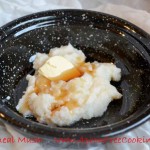Cornmeal Mush
 Fried cornmeal mush is a Southern dish that is nearly as old as time itself. The flavor is slightly sweet and the texture is creamy.
Fried cornmeal mush is a Southern dish that is nearly as old as time itself. The flavor is slightly sweet and the texture is creamy.
You can top it with butter and syrup. You can eat it plain. You can melt cheese into it. This dish can be eaten for breakfast, lunch or dinner.
It seems that folks either are fans of this dish, or they’re not. I haven’t found much middle ground – people who say, “Oh it’s all right, I eat it some times.” What I’ve found is that people love cornmeal mush or they dislike it. They eat it often or never. Interesting how a food can be so polarizing, isn’t it?
What is Cornmeal?
The first part of the discussion always begins with a definition of cornmeal. That should be simple enough, one would think. However, there is lots of room for discussion on what consists of a proper cornmeal.
Basically, cornmeal is ground corn. I know, simple, right?
The debate starts with the type of corn that is ground – yellow, white, blue, red or a combination. Fans of Southern style cooking typically prefer white cornmeal. I’ve discovered that yellow cornmeal is preferred in New England states and the Midwest. Or, maybe that’s just my family’s preference and so I assume it holds true for the entire regions!
Then there is the whole conversation about grinding – stone ground vs. steel cut, finely ground vs. coarsely ground. I suppose the texture you select will be determined by the recipe you want to make. Grits, for example are best made from a coarse ground corn. Muffins are better when made from a finely ground cornmeal. And you can imagine there is a whole spectrum in between.
I like to use packaged mixes when making muffins – those usually have wheat flour and baking soda or other leavening agents mixed in pre-proportioned amounts. That makes my baking job a lot simpler since all I need to add are the wet ingredients.
But when I make Indian Pudding, Boston Brown Bread or cornmeal mush, I use a straight up plain old fashioned corn meal. Depending on what my store has in stock, I’ve used Indian Head Cornmeal, Bob’s Red Mill, Martha White’s and Quaker brands. I’ve had success with all of the brands. This column is not an endorsement for any particular brand and I recommend you find one that you like based on your lifestyle.
Is cornmeal gluten free? If you are considering a gluten free diet, I suggest you do some research on this matter. I am not a gluten free expert or a certified nutritionist – but it seems that corn in most cases is a gluten free product based on my preliminary research.
Cornmeal Mush Recipe
Ingredients
- 1 cup cold water
- 1 cup cornmeal
- 1 tsp sugar
- 3 cups hot water
- 1 tsp salt
Instructions
- In a small bowl, mix the cold water, cornmeal and sugar. Set the bowl aside so the corn can absorb the water.
- In a medium saucepan, bring the hot water and salt to a boil. Turn the heat to medium. Add the corn mixture, stirring constantly until the mixture thickens.
- Allow to cook for about 3 minutes, then transfer the corn mixture into a greased loaf pan. Set on a cooling rack on the counter and allow to cool to room temperature. Once cooled, transfer to refrigerator for 6 hours or overnight.
- Slice the cooled mush into 1 inch slices and fry in hot oil in your cast iron skillet.
Approximate Nutritional Information:
Servings Per Recipe: 6, Amount Per Serving: Calories: 132, Fat: 2g, Cholesterol: 0mg, Sodium: 23g, Total Carbs: 29g, Protein: 5g.
Make It a Meal:
Serve with a bit of butter and maple syrup beside your eggs.
Variations:
Mix in some shredded cheddar cheese or some taco seasoning for a bit of kick.
What is Polenta?
Polenta is another name for cornmeal mush. What? you may ask! Yes, yes, yes it is. I’m sorry to break the news to you, but this wonderful dish was too good to be known by just a single name. Or at least, that’s my way of thinking!
Polenta is the Italian name for cornmeal that has been boiled into a porridge, cooled, sliced and fried. (Sound familiar?) The Italians serve their dish made from the yellow cornmeal and topped with sauces or even grilled meats.
In fact, you may often find polenta served in similar ways to mashed potatoes, rice or pasta.
If your family seems skeptical of a dish named “mush” then perhaps you’ll want to serve them “polenta”. I know my kids developed a dislike of Brussels sprouts when they were in elementary school. They sure did love the “mon petit choux”, however. The name has a way of making the food more appealing! A loose translation of the French name is “my little cabbage head”.
Having shared that story, you know I’m not above serving a menu item with a fancy sounding name and good old fashioned taste!
I think it is quite interesting that a peasant food from northern Italy began in the Americas and traveled over the seas in the 1400s. Then again, the tomato, which has also become synonymous with Italian cooking made that same journey. Apparently the Italians are masters at incorporating new foods into their cuisine. I sure don’t mind!
Interested in one of the books pictured above? You can purchase on Amazon here.

